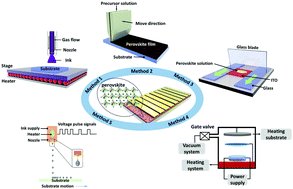当前位置:
X-MOL 学术
›
Chem. Soc. Rev.
›
论文详情
Our official English website, www.x-mol.net, welcomes your feedback! (Note: you will need to create a separate account there.)
Understanding of perovskite crystal growth and film formation in scalable deposition processes
Chemical Society Reviews ( IF 46.2 ) Pub Date : 2020/03/05 , DOI: 10.1039/c9cs00711c Chang Liu 1, 2, 3, 4 , Yi-Bing Cheng 5, 6, 7, 8 , Ziyi Ge 1, 2, 3, 4
Chemical Society Reviews ( IF 46.2 ) Pub Date : 2020/03/05 , DOI: 10.1039/c9cs00711c Chang Liu 1, 2, 3, 4 , Yi-Bing Cheng 5, 6, 7, 8 , Ziyi Ge 1, 2, 3, 4
Affiliation

|
Hybrid organic–inorganic perovskite photovoltaics (PSCs) have attracted significant attention during the past decade. Despite the stellar rise of laboratory-scale PSC devices, which have reached a certified efficiency over 25% to date, there is still a large efficiency gap when transiting from small-area devices to large-area solar modules. Efficiency losses would inevitably arise from the great challenges of homogeneous coating of large-area high quality perovskite films. To address this problem, we provide an in-depth understanding of the perovskite nucleation and crystal growth kinetics, including the LaMer and Ostwald ripening models, which advises us that fast nucleation and slow crystallization are essential factors in forming high-quality perovskite films. Based on these cognitions, a variety of thin film engineering approaches will be introduced, including the anti-solvent, gas-assisted and solvent annealing treatments, Lewis acid–base adduct incorporation, etc., which are able to regulate the nucleation and crystallization steps. Upscaling the photovoltaic devices is the following step. We summarize the currently developed scalable deposition technologies, including spray coating, slot-die coating, doctor blading, inkjet printing and vapour-assisted deposition. These are more appealing approaches for scalable fabrication of perovskite films than the spin coating method, in terms of lower material/solution waste, more homogeneous thin film coating over a large area, and better morphological control of the film. The working principles of these techniques will be provided, which direct us that the physical properties of the precursor solutions and surface characteristics/temperature of the substrate are both dominating factors influencing the film morphology. Optimization of the perovskite crystallization and film formation process will be subsequently summarized from these aspects. Additionally, we also highlight the significance of perovskite stability, as it is the last puzzle to realize the practical applications of PSCs. Recent efforts towards improving the stability of PSC devices to environmental factors are discussed in this part. In general, this review, comprising the mechanistic analysis of perovskite film formation, thin film engineering, scalable deposition technologies and device stability, provides a comprehensive overview of the current challenges and opportunities in the field of PSCs, aiming to promote the future development of cost-effective up-scale fabrication of highly efficient and ultra-stable PSCs for practical applications.
中文翻译:

了解可扩展沉积工艺中钙钛矿晶体的生长和成膜
在过去的十年中,有机-无机钙钛矿混合光伏(PSC)引起了极大的关注。尽管实验室规模的PSC装置取得了令人瞩目的增长,迄今为止已达到25%的认证效率,但从小面积的设备向大面积的太阳能模块过渡时,效率差距仍然很大。大面积高质量钙钛矿薄膜均匀涂层的巨大挑战将不可避免地带来效率损失。为解决此问题,我们提供了钙钛矿成核和晶体生长动力学的深入理解,包括LaMer和Ostwald成熟模型,该模型建议我们快速成核和缓慢结晶是形成高质量钙钛矿薄膜的重要因素。基于这些认识,等等,它们能够调节成核和结晶步骤。升级光伏设备是以下步骤。我们总结了当前开发的可扩展沉积技术,包括喷涂,狭缝模头涂布,刮刀刮涂,喷墨印刷和蒸气辅助沉积。与较低的材料/溶液浪费,在大面积上更均匀的薄膜涂层以及更好的薄膜形态控制相比,这些方法比旋涂方法更具吸引力,可用于钙钛矿薄膜的可扩展制造。将提供这些技术的工作原理,这些原理指导我们前体溶液的物理性质和基材的表面特性/温度都是影响薄膜形态的主要因素。随后将从这些方面总结钙钛矿结晶和膜形成工艺的优化。此外,我们还强调了钙钛矿稳定性的重要性,因为这是实现PSC实际应用的最后难题。本部分讨论了最近为改善PSC器件对环境因素的稳定性所做的努力。总的来说,这篇综述包括钙钛矿膜形成的机械分析,薄膜工程,可扩展的沉积技术和器件稳定性,提供了PSC领域当前挑战和机遇的全面概述,旨在促进成本的未来发展。用于实际应用的高效,高效,超稳定的PSC的大规模生产。
更新日期:2020-03-24
中文翻译:

了解可扩展沉积工艺中钙钛矿晶体的生长和成膜
在过去的十年中,有机-无机钙钛矿混合光伏(PSC)引起了极大的关注。尽管实验室规模的PSC装置取得了令人瞩目的增长,迄今为止已达到25%的认证效率,但从小面积的设备向大面积的太阳能模块过渡时,效率差距仍然很大。大面积高质量钙钛矿薄膜均匀涂层的巨大挑战将不可避免地带来效率损失。为解决此问题,我们提供了钙钛矿成核和晶体生长动力学的深入理解,包括LaMer和Ostwald成熟模型,该模型建议我们快速成核和缓慢结晶是形成高质量钙钛矿薄膜的重要因素。基于这些认识,等等,它们能够调节成核和结晶步骤。升级光伏设备是以下步骤。我们总结了当前开发的可扩展沉积技术,包括喷涂,狭缝模头涂布,刮刀刮涂,喷墨印刷和蒸气辅助沉积。与较低的材料/溶液浪费,在大面积上更均匀的薄膜涂层以及更好的薄膜形态控制相比,这些方法比旋涂方法更具吸引力,可用于钙钛矿薄膜的可扩展制造。将提供这些技术的工作原理,这些原理指导我们前体溶液的物理性质和基材的表面特性/温度都是影响薄膜形态的主要因素。随后将从这些方面总结钙钛矿结晶和膜形成工艺的优化。此外,我们还强调了钙钛矿稳定性的重要性,因为这是实现PSC实际应用的最后难题。本部分讨论了最近为改善PSC器件对环境因素的稳定性所做的努力。总的来说,这篇综述包括钙钛矿膜形成的机械分析,薄膜工程,可扩展的沉积技术和器件稳定性,提供了PSC领域当前挑战和机遇的全面概述,旨在促进成本的未来发展。用于实际应用的高效,高效,超稳定的PSC的大规模生产。



























 京公网安备 11010802027423号
京公网安备 11010802027423号